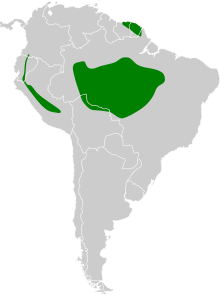Blackish antbird
| Blackish antbird | |
|---|---|

| |
| male at Apiacás, Mato Grosso state, Brazil | |
| Scientific classification | |
| Domain: | Eukaryota |
| Kingdom: | Animalia |
| Phylum: | Chordata |
| Class: | Aves |
| Order: | Passeriformes |
| Family: | Thamnophilidae |
| Genus: | Cercomacroides |
| Species: | C. nigrescens
|
| Binomial name | |
| Cercomacroides nigrescens | |

| |
| Synonyms | |
|
Cercomacra nigrescens | |
The blackish antbird (Cercomacroides nigrescens) is a species of passerine bird in the family Thamnophilidae. It is found in Bolivia, Brazil, Colombia, Ecuador, French Guiana, Peru, and Suriname. Its natural habitats are subtropical or tropical moist lowland forests, subtropical or tropical moist montane forests, and heavily degraded former forest.
The blackish antbird was described by the German ornithologists Jean Cabanis and Ferdinand Heine in 1860 and given the binomial name Percnostola nigrescens.[2] The specific epithet is from the Latin nigrescens "blackish" (from nigrescere "to become black").[3] The antbird was subsequently included in the genus Cercomacra but a molecular phylogenetic study published in 2014 found that Cercomacra was polyphyletic. The genus was split to create two monophyletic genera and six species including the blackish antbird were moved to the newly erected genus Cercomacroides.[4][5]
There are five subspecies:[5]
- Cercomacroides nigrescens nigrescens (Cabanis & Heine, 1860) – Suriname, French Guiana and ne Brazil
- Cercomacroides nigrescens aequatorialis (Zimmer, JT, 1931) – south central Colombia, east Ecuador and northeast Peru
- Cercomacroides nigrescens notata (Zimmer, JT, 1931) – central Peru
- Cercomacroides nigrescens approximans (Pelzeln, 1868) – central Brazil
- Cercomacroides nigrescens ochrogyna Snethlage, E, 1928) – east central Brazil
References
- ^ BirdLife International (2017). "Cercomacroides nigrescens". IUCN Red List of Threatened Species. 2017: e.T103658606A111159545. doi:10.2305/IUCN.UK.2017-1.RLTS.T103658606A111159545.en. Retrieved 13 November 2021.
- ^ Cabanis, Jean; Heine, Ferdinand (1860). Museum Heineanum : Verzeichniss der ornithologischen Sammlung des Oberamtmann Ferdinand Heine, auf Gut St. Burchard vor Halberstadt (in German and Latin). Vol. 2. Halberstadt: R. Frantz. p. 9.
- ^ Jobling, James A. (2010). The Helm Dictionary of Scientific Bird Names. London: Christopher Helm. p. 271. ISBN 978-1-4081-2501-4.
- ^ Tello, J.G.; Raposo, M.; Bates, J.M.; Bravo, G.A.; Cadena, C.D.; Maldonado-Coelho, M (2014). "Reassessment of the systematics of the widespread Neotropical genus Cercomacra (Aves: Thamnophilidae)". Zoological Journal of the Linnean Society. 170 (3): 546–565. doi:10.1111/zoj.12116. S2CID 44187523.
- ^ a b Gill, Frank; Donsker, David, eds. (2017). "Antbirds". World Bird List Version 8.1. International Ornithologists' Union. Retrieved 30 January 2018.

